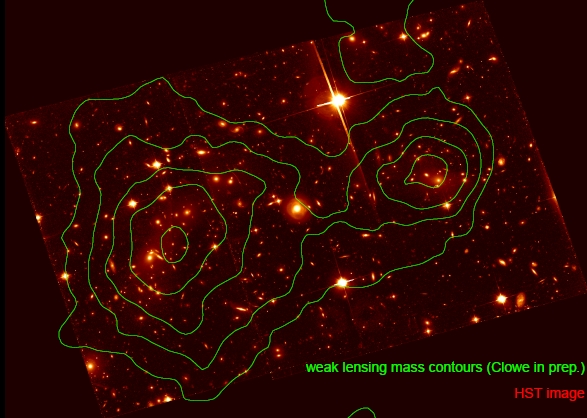No, you misunderstood the article. There is gravitational lensing by both the stars and something that does not glow. The plasma is no "glowing brightly".
Perhaps if you understood the evidence for dark matter better you could come up with a better argument against it.
I've actually read the whole paper several times now, and even the title of their paper should demonstrate their lack of understanding of some core facts about "science". There is no such thing as 'proof' of anything in science. There certainly is no such thing as 'proof' in an uncontrolled observation, devoid of any control mechanisms entirely. The *most* you can hope to provide is "evidence" in the realm of real physics. What they *actually* have is nothing more than lensing evidence of "missing mass" from an area inside the collision zone that isn't "visible' to us with our *relatively primitive* technology. Yawn.
What you have are the stellar infrastructures of both galaxies passing through each other relatively unscathed, including their supermassive "black holes" in each galaxy. The x-ray zone is clearly the plasma that is still colliding and interaction and glowing brightly still in x-ray. The "stuff around the stellar infrastructure that they don't see" is the light plasma that has already *passed through* the collision zone, and all the neutrally charged particles and dust that are unlikely to have any EM influences on each other as they "pass on through".
Lensing data, and/or the ability to "see" the plasma at these distances in *no way* implies or requires the existence of "exotic matter".
There is no doubt at all that there is *missing mass* in that image alright. We know for instance they *underestimated* the stellar infrastructure by a whopping factor of four, and they underestimated the brightness by *at least* a factor of 2. Furthermore, from 20/20 hindsight we also know that they *underestimated* the size of the supermassive black holes, and they only just recently found/confirmed the existence of the plasma around the galaxies as late as 2012. Who knows what *else* they haven't found yet?
Looking at that lensing data and claiming it's necessarily made of "exotic" matter, rather than ordinary dust and plasma is the like seeing something unusual in the sky and *assuming* it's *necessarily* built by an intelligent race from another planet!

Sure, there is that *possibility*, but it certainly wouldn't be the first conclusion I *leap* to, particularly considering the relatively primitive state of our technologies, and the consistently *demonstrated flaws* in mainstream galaxy mass estimates.
The real "kicker" however is that they treat all particles alike, regardless of *charge*, and that's just utterly ridiculous, particularly when discussing *this particular* data. The charged particles in the plasma will *repel/interact* with each other more readily, and from a greater distance, than any *neutrally charged* particles. The neutral part of those dust clouds will likely just "pass on though" the collision, while the charged particles will definitely be more *interactive* with the charged particles from the other dust cloud. All "plasmas" have 'dust', some of which *will not have a charge*!
The fact the mainstream *utterly ignores the charge of the various particles* makes their claims utterly absurd and childish. Their thinking is just *so primitive* in terms of plasma physics, it's not even funny.
Last edited:
Upvote
0

